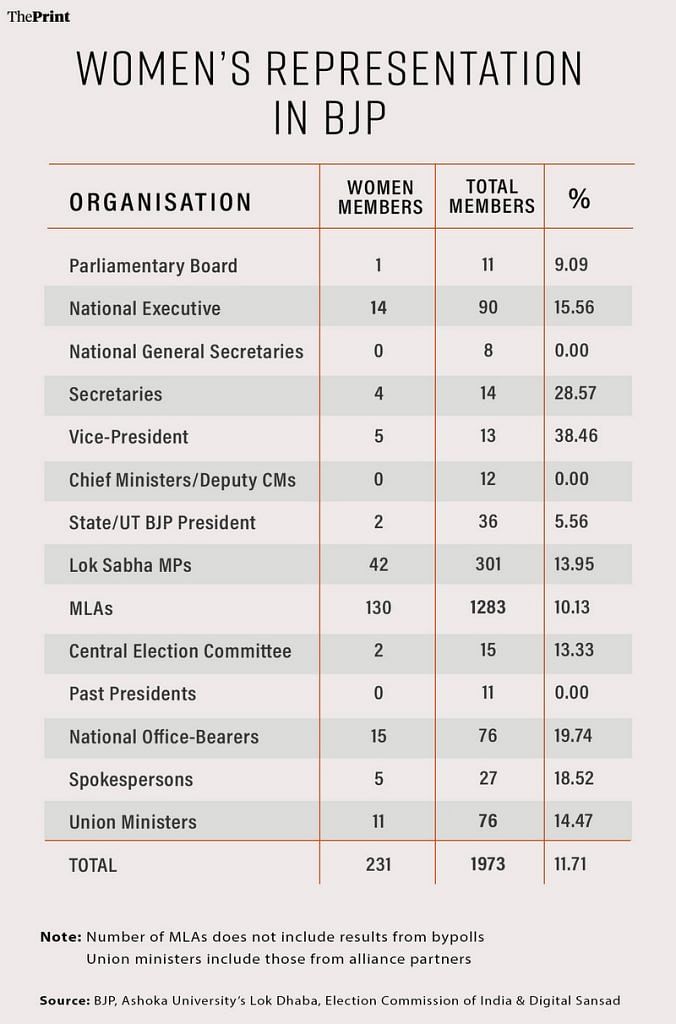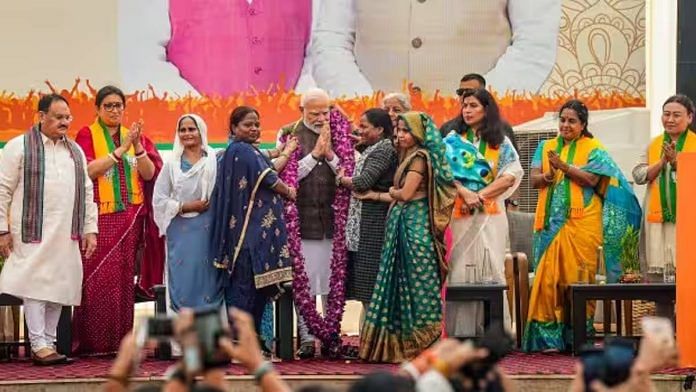New Delhi: The Modi government is calling the parliamentary approval of the Women’s Reservation Bill, granting women a 33 percent quota in the Lok Sabha and state assemblies, a “historic” moment. However, the BJP itself is largely a male preserve. In fact, the party hasn’t followed its own constitution that mandates a one-third quota for women in its national executive.
As it stands today, there are only 14 women — 15.56 percent — in the 90-member BJP national executive. All these were appointed in 2021 when party president JP Nadda assembled the national executive, then consisting of 80 members, including Prime Minister Narendra Modi and Union ministers Rajnath Singh, Amit Shah, and Piyush Goyal, among other senior leaders.
Subsequently, in December 2022, three more leaders, all men, were added to the national executive— Captain Amarinder Singh, Sunil Jakhar and Swatantra Dev. Again, in July 2023, when the BJP president unveiled a list of 10 new members (while also removing three), not a single woman made the cut.
But the gender imbalance extends well beyond the national executive. The BJP has just one woman in its 11-member parliamentary board and two in its 15-member central election committee. There are only two women among the 36 state/Union territory BJP presidents, and all the eight national general secretaries are men. Not even one among the 12 chief ministers and deputy chief ministers of the party is a woman.

There have been 11 national presidents of the BJP since its formation in 1980, but a woman has never held the top post despite the party having had several formidable mass leaders within its ranks, including Sushma Swaraj, Vasundhara Raje, and Uma Bharti, among others.
The second most important post in the BJP is of national general secretary (organisation) but that too has remained an exclusively male preserve, as the occupant of this position is typically deputed from the Rashtriya Swayamsevak Sangh, the party’s ideological parent.
When asked about the under-representation of women in her party, journalist-turned-politician Shazia Ilmi said that the BJP had given more opportunities to first-time women politicians than other parties.
“For us, merit is equally important. But the BJP has always stood for women’s rights, which is why there has been a first woman finance minister and the very first woman defence minister,” she said. Both these ‘firsts’ pertain to Nirmala Sitharaman, currently finance minister.
“Not only this, the BJP gave the country its first ever tribal president who is a woman (Droupadi Murmu). Who are the other women from different parties? (Former Lok Sabha Speaker) Meira Kumar of the Congress was the daughter of (late deputy PM) Babu Jagjivan Ram,” Ilmi added. “The BJP gave opportunities to women who are not just wives and daughters of politicians. Which other party in the country has ever done that?”
BJP national spokesperson Guru Prakash Paswan also pointed to Sitharaman and President Murmu.
“A woman from the tribal community has reached the highest constitutional office for the first time in the history of our country. For the first time, we have the highest representation of women in the Union Council of Ministers. A woman as defence minister and a woman as finance minister has been possible in this government,” he said. “Our motto is sabka saath, sabka vikas and it is a matter of commitment for us.”
Also Read: Issue that derailed women’s quota Bill in ’96 still stands—Indian feminism lacks diversity
8 national general secretaries, not one woman
Despite the utterances of its leaders, the severe under-representation of women in most organisational bodies of the BJP stands out.
In the highest decision-making body of the party — the parliamentary board — of 11 members, only one is a woman.
The board includes Narendra Modi, J.P. Nadda, Rajnath Singh, Amit Shah, B.S. Yediyurappa, Sadanand Sonowal, K. Laxman, Iqbal Singh Lalpura, Satyanarayan Jatiya and B.L. Santhosh. The only woman in the panel is former MP Sudha Yadav.
Among the 15 members in the central election committee (CEC), only two are women — Sudha Yadav and Vanathi Srinivasan. The role of the committee is to select candidates for all legislative and parliamentary elections. It is chaired by PM Modi.
In posts of power, women’s representation is no better. Among eight national general secretaries, not a single member is a woman.
D. Purandeswari was a national general secretary until she was appointed Andhra BJP chief. Among state/UT presidents of the BJP — only two of 36 are women — Purandeshwari (Andhra Pradesh) and Sharda Devi (Manipur).
More than a third of the party vice-presidents are women though — five of 13. But the vice-president’s post in the BJP is largely ceremonial with few such appointees given charge of any state or important assignments.
Out of 14 BJP secretaries, four are women — Vijaya Rahatkar, Pankaja Munde, Alka Gurjar and Asha Lakra.
Of the 27 national spokespersons, only five are women — Sanju Verma, Aparajita Sarangi, Heena Gavit, Shazia Ilmi, and Bharati Ghosh.
In all, the party has 76 national office-bearers, of which 15 are women. The national office-bearers include president, vice-presidents, national general secretaries, national general secretary (organisation), joint general secretary (organisation), national spokespersons, national secretary, treasurer, joint treasurer, office secretary, in-charge of national IT and social media and presidents of Yuva Morcha, Mahila Morcha, OBC Morcha, Kisan Morcha, SC Morcha, ST Morcha and Minority Morcha.
When it comes to the Modi cabinet, there are two women among its 28 members — Nirmala Sitharaman and Smriti Irani. Further, in the entire 76-member Council of Ministers, there are 11 women. These include ministers from alliance partners.
Only 14% MPs and 10% MLAs are women
Coming to the Lok Sabha, the BJP has 301 MPs, of which only 42 or 14 per cent are women. And among its 1,283 MLAs across various state assemblies, only 130 or 10 per cent are women, according to data from Ashoka University’s Lok Dhaba portal and the Election Commission of India. The MLAs include members who won the most recent assembly election (not including bypolls).
Speaking on the reasons behind the low percentage of women representatives, Sanjay Kumar from the Centre for the Study of Developing Societies (CSDS), told ThePrint: “The reason is simple. Most of the political parties have a shared belief that women are not prepared enough to take part in politics. Thus, fewer party positions are given.”
However, he believes, that the women’s reservation bill will, “by default”, lead to induction of more women leaders in political parties.
“Yes, there are chances parties will try and induct more women. They would want to know who is capable enough of being given a ticket. That would motivate the party to encourage women to join. Though there is no formal laying down of rules in the reservation Bill for a party to induct women, by default they will be inducted,” Kumar explained.
With inputs from Unnati Sharma
(Edited by Nida Fatima Siddiqui)
Also Read: Modi’s Women’s Reservation Bill has an OBC-sized oversight. Undermines inclusivity, fairness



